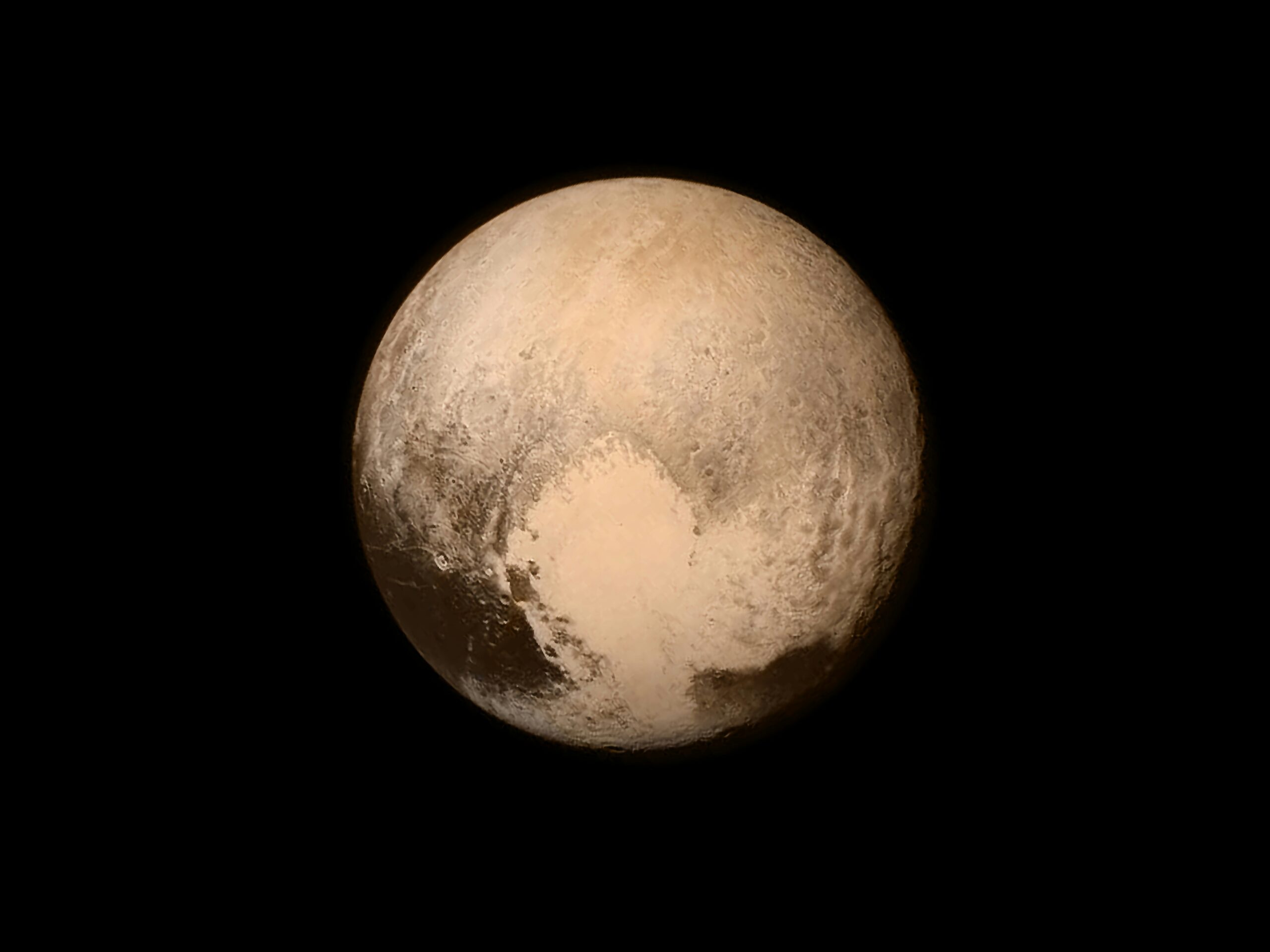Journey with us to the cold, distant edge of our solar system, where a tiny world full of surprises awaits! Once called the ninth planet, Pluto may have been reclassified, but it still packs a cosmic punch with heart-shaped glaciers, icy mountains, and a family of five fascinating moons. Whether you’re a stargazer or a science lover, these 100 bite-sized facts will reveal why Pluto continues to captivate our imaginations and remind us that even the smallest worlds can hold the grandest mysteries. 🌌✨
- Pluto was discovered on February 18, 1930, by astronomer Clyde Tombaugh at the Lowell Observatory in Arizona.
- Pluto was once considered the ninth planet in our Solar System until it was reclassified as a dwarf planet by the International Astronomical Union (IAU) in 2006.
- It takes Pluto about 248 Earth years to complete one orbit around the Sun.
- Pluto’s orbit is highly elliptical, bringing it closer to the Sun than Neptune for approximately 20 years of its orbital cycle.
- Pluto’s rotation period (one full day) is about 6.4 Earth days.
- The average distance of Pluto from the Sun is around 5.9 billion kilometers (3.7 billion miles).
- Pluto’s largest moon, Charon, was discovered in 1978 by James Christy.
- Charon is about half the diameter of Pluto, making it unusually large compared to its parent planet.
- Because Pluto and Charon orbit a common barycenter outside Pluto’s surface, they are sometimes considered a binary system.
- Pluto has five known moons: Charon, Styx, Nix, Kerberos, and Hydra.
- Pluto’s atmosphere primarily consists of nitrogen, methane, and carbon monoxide.
- Pluto’s surface temperature can reach as low as -229°C (-380°F), making it one of the coldest places in the Solar System.
- The dwarf planet’s surface is composed mainly of nitrogen ice, with traces of methane and carbon monoxide ice.
- Pluto’s heart-shaped glacier is named Tombaugh Regio, after its discoverer.
- The western lobe of Tombaugh Regio, called Sputnik Planitia, is a smooth, nitrogen-ice plain with no visible craters.
- Pluto’s diameter is approximately 2,377 kilometers (1,477 miles), making it smaller than Earth’s moon.
- Pluto’s gravity is about 1/15 of Earth’s gravity—meaning you’d weigh significantly less there!
- Pluto’s thin atmosphere expands when it moves closer to the Sun and freezes as it moves farther away.
- Pluto’s color varies from shades of white and gray to red and brown due to complex organic molecules called tholins.
- In 2015, NASA’s New Horizons spacecraft provided the first detailed images of Pluto, revealing its diverse and active geology.
- New Horizons discovered that Pluto has mountain ranges as high as 3,500 meters (11,500 feet), composed mainly of water ice.
- Pluto also has vast plains, canyons, and dunes, indicating active geological processes.
- New Horizons traveled nearly 9.5 years and about 4.9 billion kilometers (3 billion miles) to reach Pluto.
- Pluto is located in the Kuiper Belt, a region of space filled with icy objects beyond Neptune’s orbit.
- Clyde Tombaugh’s ashes were placed aboard New Horizons, symbolically visiting Pluto.
- Pluto was named by Venetia Burney, an 11-year-old schoolgirl from England who suggested naming it after the Roman god of the underworld.
- Pluto’s orbit is tilted by about 17 degrees compared to the other planets in our Solar System.
- Pluto spins backward (retrograde rotation) relative to its orbit around the Sun, similar to Venus and Uranus.
- Pluto’s small size and unusual orbit led astronomers to question its planetary status long before its reclassification.
- Pluto receives about 1/900th the sunlight Earth receives.
- Despite its distant location, Pluto’s sky appears surprisingly blue, due to sunlight scattering off its atmospheric particles.
- Scientists theorize that Pluto might have an underground ocean beneath its icy surface, potentially harboring conditions suitable for microbial life.
- Pluto’s thin atmosphere is gradually escaping into space due to solar winds and weak gravitational pull.
- Pluto’s moons have highly irregular shapes, except Charon, which is spherical due to its gravitational pull.
- Pluto has a very faint ring system, detected indirectly through the observations of moons and dust particles.
- The discovery of other objects similar in size to Pluto, like Eris, influenced the decision to reclassify Pluto as a dwarf planet.
- Pluto’s axial tilt is approximately 120 degrees, causing extreme seasonal variations over its long orbit.
- Before its reclassification, Pluto was the smallest planet in the Solar System.
- Pluto’s mountains are surprisingly young geologically, possibly less than 100 million years old, indicating geological activity.
- The reddish regions on Pluto’s surface are caused by ultraviolet radiation interacting with methane, creating complex organic compounds.
- Pluto’s brightness varies depending on its distance from the Sun and the angle of sunlight hitting its surface.
- Pluto’s moons Nix and Hydra rotate chaotically due to gravitational interactions with Pluto and Charon.
- In Roman mythology, Pluto is the god of the underworld, fitting for the dwarf planet’s remote and cold environment.
- New Horizons sent back data at speeds so slow (about 1 kilobit per second) that it took over a year to transmit all its collected information.
- Pluto’s orbit crosses Neptune’s orbit, but due to their orbital resonances, they will never collide.
- The dwarf planet’s surface pressure is about 100,000 times lower than Earth’s.
- Pluto was demoted from planetary status because it didn’t clear its orbital neighborhood of debris, a requirement set by the IAU for planet classification.
- Pluto is one of the largest known objects in the Kuiper Belt but not the largest—that title goes to Eris.
- Before the New Horizons mission, Pluto’s surface was largely unknown, appearing as just a blurry dot even with powerful telescopes.
- Despite its demotion, Pluto remains a cultural favorite and continues to inspire curiosity and imagination worldwide. 🌠🚀
- Pluto’s day (rotation) is shorter than its largest moon Charon’s orbit, meaning Charon always appears in the same spot in Pluto’s sky.
- Charon is tidally locked with Pluto, so Pluto and Charon always show the same face to each other.
- Pluto’s surface pressure is approximately 10 microbars, extremely thin compared to Earth’s atmosphere.
- Pluto is less dense than Earth, with an average density of about 1.85 grams per cubic centimeter.
- The escape velocity of Pluto is just about 1.2 kilometers per second, compared to Earth’s 11.2 kilometers per second.
- New Horizons passed Pluto at a speed of about 49,600 kilometers per hour (30,800 miles per hour).
- Pluto’s internal structure likely consists of a rocky core surrounded by a mantle of water ice.
- The Sputnik Planitia basin may be the result of an ancient impact that created a massive crater filled with nitrogen ice.
- Cryovolcanism (ice volcanoes) has been observed on Pluto, hinting at geological processes and internal heating.
- The Wright Mons volcano on Pluto is approximately 4 kilometers high and 150 kilometers wide, thought to be an ice volcano.
- The Al-Idrisi Montes mountains on Pluto are made of water ice and rise up to 3 kilometers (nearly 10,000 feet) high.
- Pluto’s polar regions are covered in methane ice, which is why they appear white and frosty.
- Pluto’s surface features include massive ridges, grooves, and vast networks of canyons.
- The Tartarus Dorsa mountains on Pluto have bizarre, snake-like ridges made of methane ice.
- Pluto’s surface geology is surprisingly diverse, similar to Mars, including ancient terrains, plains, and volcanic-like mountains.
- Pluto has no magnetic field, likely due to its small size and slow rotation.
- Pluto’s orbit is influenced by the gravitational tug of Neptune, maintaining a stable orbital resonance.
- Before Pluto’s discovery, astronomers predicted its existence due to perceived gravitational anomalies affecting Neptune and Uranus.
- The search for Pluto (Planet X) began around 1906, decades before its actual discovery in 1930.
- Pluto’s orbital inclination means it sometimes moves significantly above or below the plane of the Solar System’s other planets.
- Pluto was initially believed to be much larger, comparable in size to Earth, but later observations revealed its smaller dimensions.
- Pluto’s eccentric orbit occasionally causes atmospheric pressure fluctuations as nitrogen freezes or sublimates.
- The small moons of Pluto were discovered between 2005 and 2012, largely thanks to the Hubble Space Telescope.
- Pluto’s surface shows signs of past or present wind, despite its thin atmosphere.
- Scientists believe Pluto’s ocean, if it exists beneath its icy crust, could contain ammonia, helping it remain liquid at extremely low temperatures.
- Pluto’s moons Hydra and Nix are irregularly shaped and spin unpredictably due to chaotic rotation.
- Pluto’s orbit is so vast that no human alive today has witnessed it complete even half an orbit since its discovery.
- Before the New Horizons mission, Pluto was the only known planet (or dwarf planet) never explored by spacecraft.
- NASA’s New Horizons mission sent back more than 400 scientific observations of Pluto.
- The reddish regions on Pluto have intrigued scientists who suspect the presence of complex, carbon-rich organic compounds.
- Pluto’s tenuous atmosphere creates layered haze extending as high as 160 kilometers (100 miles) above its surface.
- New Horizons’ closest approach to Pluto was about 12,500 kilometers (7,800 miles) from the dwarf planet’s surface.
- The smallest moon of Pluto, Styx, is roughly only 16 kilometers (10 miles) at its longest dimension.
- Pluto’s moons have mythological names associated with the underworld in Greek mythology, matching the dwarf planet’s theme.
- Pluto’s orbit is so elongated that when closest to the Sun (perihelion), it’s nearly 50% closer than when at its farthest point (aphelion).
- The dwarf planet Haumea shares some orbital characteristics with Pluto, residing in the Kuiper Belt region as well.
- Pluto’s gravity is so weak that a person weighing 68 kilograms (150 pounds) on Earth would weigh only about 4.5 kilograms (10 pounds) on Pluto.
- Pluto’s eccentric orbit makes it occasionally more visible from Earth’s perspective, though it still requires powerful telescopes.
- Pluto was originally named “Planet X”, a placeholder indicating a predicted unknown planet beyond Neptune.
- In 1989, Pluto reached perihelion, its closest point to the Sun, and it won’t be this close again until the year 2237.
- Pluto’s heart-shaped region, Sputnik Planitia, is geologically young, estimated to be less than 10 million years old.
- Pluto’s position in the Kuiper Belt makes it a valuable object for studying the early history of our Solar System.
- Some scientists advocate for Pluto’s return to planetary status, citing geological complexity and historical precedent.
- New Horizons continues beyond Pluto, exploring other distant Kuiper Belt Objects (KBOs), like Arrokoth, visited in 2019.
- Pluto’s distance from Earth changes significantly, ranging between approximately 4.3 billion km (2.67 billion miles) and over 7.5 billion km (4.67 billion miles).
- Scientists believe Pluto’s reddish terrain is similar to the tholins found on Saturn’s moon Titan.
- When Pluto crosses Neptune’s orbit, their paths remain stable due to gravitational resonance preventing any collision.
- Pluto’s surface has dune-like structures, indicating wind-driven geological processes despite its thin atmosphere.
- New Horizons carried sophisticated instruments such as Alice (an ultraviolet imaging spectrometer) and Ralph (a visible and infrared camera/spectrometer).
- Pluto remains beloved in popular culture, frequently appearing in science fiction, art, literature, and astronomy outreach.

